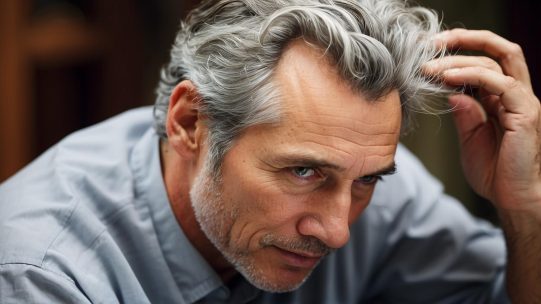Here’s how hormones and chemotherapy can change your hair: from straight to curly, from thick to thin.

Hair comes in many colors, shapes and sizes, and hairstyles are often an expression of personal style or cultural identity.
Many different genes determine the texture, thickness and color of our hair. However, some people’s hair changes after puberty, pregnancy, or chemotherapy.
So, what can make the hair curlier, thick, thin or gray.
Curly or straight. How the shape of the hair follicle plays a role.
Hair is made of keratin, a strong and insoluble protein. Each hair strand grows from its own hair follicles, which extend deep into the skin.
Curly hair is formed due to the asymmetry of both the hair follicle and the keratin of the hair.
The follicles that produce curly hair are asymmetrical and curved, lying at an angle to the surface of the skin. It first kinks the hair when it grows.
Asymmetry in the hair follicles also causes keratin to bundle on one side of the hair strand. This will allow some of the strands of the hair to approach the curls and maintain the curls as the hair continues to grow.
Symmetrical, round and perpendicular to the skin surface hair follicles produce straight hair.
Life changes, hair changes
Our hair undergoes repeated cycles throughout life, at different stages of growth and loss.
Each hair follicle contains stem cells that increase and grow into the fibers of the hair.
Hair on the head spends most of its time during the growing season, but this can last for several years. This is why hair on the head grows longer.
Let’s look at the life span of a single hair. The growth period is a transitional period of about 2 weeks, and the hair strands cease to grow. This is followed by a resting phase where the hair remains in the follicle for a few months before it falls naturally.
Hair follicles remain in the skin and stem cells grow new hair to repeat the cycle. Each hair on the scalp is replaced every 3-5 years.
Hormonal changes during and after pregnancy change the normal hair cycle.
Many women notice that their hair is getting thicker during pregnancy.
During pregnancy, high levels of estrogen, progesterone and prolactin prolong the rest period of the hair cycle. This means that the hair stays in the hair follicle for longer, with less hair loss.
If the hormone drops a few months after childbirth, hair loss increases. This is due to the fact that during pregnancy all the hairs that remained in the rest period fall out in a fairly synchronous way.
Hair can change during puberty, during pregnancy, or after chemotherapy.
This is related to the genetics of the shape of the hair, which is an example of incomplete superiority.
Incomplete superiority is when there is an intermediate version of the characteristic. For hair, we have curly and straight hair genes. But when someone has 1 curly gene and 1 straight hair gene, they can have wavy hair.
Hormonal changes that occur around puberty and pregnancy can affect the function of genes. This can make the curly genes of people with wavy hair more active. This can cause hair to change from wavy to curly.
The researchers have identified that activating certain genes can cause pig hair to turn from straight to curly. Chemotherapy has a very visible effect on the hair.
Chemotherapy kills rapidly dividing cells, including hair follicles, which cause hair loss. Chemotherapy can also have genetic effects that affect the shape of hair follicles. This allows the hair to regrow with a different shape for the first few cycles of hair regrowth.










Comment